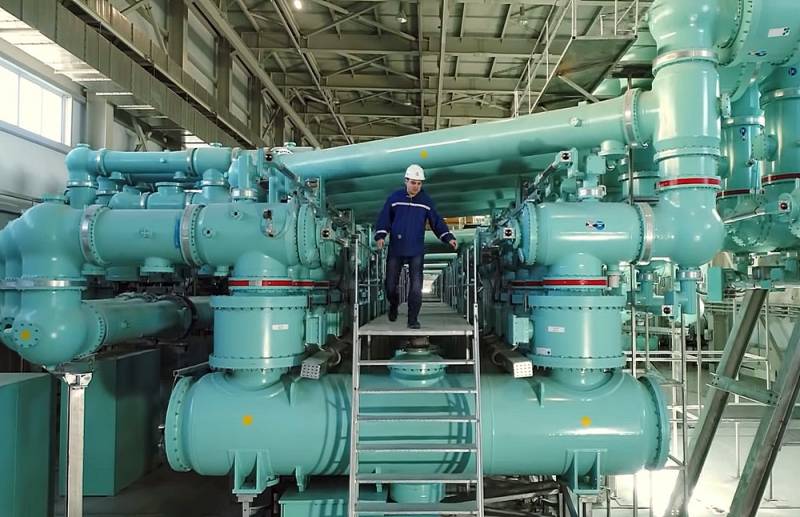What could the creation of a tripartite gas union of Moscow, Astana and Tashkent mean?
It became known that President Putin proposed to Kazakhstan and Uzbekistan, together with Russia, to form a kind of "tripartite gas union". There are no details, but it sounds very intriguing. Against whom, then, can this new alliance be concluded, and for what real purpose?
The day before, a meeting was held between Presidents Putin and Tokayev, following which the Kazakh Peskov, Tokayev’s press secretary Ruslan Zheldibay, spoke about the idea of creating a “tripartite gas union” between Russia, Kazakhstan and Uzbekistan “in order to coordinate actions in the transportation of Russian gas through the territories of Kazakhstan and Uzbekistan. In the future, our Peskov told briefly what exactly was discussed at the highest level:
What President Putin has in mind is the creation of a coordinating mechanism at the first stage. Maybe - this is still to be discussed - with some kind of legal entity, both for cooperation between these three countries, and for the development of infrastructure for foreign markets.
True, with their explanations, the press secretaries of the heads of the two states only made more fog, which we will now try to dispel. It is easy to guess that Putin's initiative, like the previously announced creation of a gas hub in Turkey, is an attempt to circumvent European restrictions on the purchase of energy from Gazprom. The only question is in which direction Russian gas can go.
Version 1. New markets
According to this hypothesis, Gazprom may try to enter the promising markets of Pakistan and India through the TAPI trunk pipeline under construction, which should connect Turkmenistan, Afghanistan, Pakistan and India. Its length will be 1735 kilometers, capacity - 33 billion cubic meters per year. The demand for energy carriers in Pakistan and especially in India is constantly growing. The main obstacle in the way of TAPI was transit Afghanistan, but the recent change of power in Kabul has rather benefited the internal stability in this country. Anyway, for now.
Theoretically, Gazprom could somehow join this project by expanding its capacity, but to do this, the main pipeline will have to be continued through the territory of Kazakhstan and Uzbekistan. It should be noted that Russian companies are already participating in the construction of the Pakistani Stream gas pipeline, which should connect the north and south of this country, which we will discuss in detail told earlier.
Version 2. Diversification
According to this hypothesis, Moscow can help Astana and Tashkent fulfill their contractual obligations to China and meet domestic gas needs. Today, Russia, Kazakhstan, and Uzbekistan simultaneously supply blue fuel to China, being competitors. The problem is that the former Soviet republics cannot quickly increase gas production and in a few years run the risk of being unable to fulfill their contractual obligations to Beijing.
Gazprom can solve this problem by redirecting part of the volumes released from the European direction to Central Asia, and Kazakhstan and Uzbekistan will sell to the Celestial Empire the gas that will not be burned for domestic consumption.
Version 3. "Central Asian mix"
As you know, in 2024 the transit agreement with Ukraine on pumping Russian gas through it to Europe expires. With a probability close to 100%, it can be argued that this contract will not be extended. Brussels and Kyiv are obediently working out the United States' plan to squeeze Gazprom out of the European market. However, there are options.
Thus, an attempt to circumvent restrictions on the purchase of sanctioned Russian oil has already led to the emergence of a “Latvian mixture”, when domestic raw materials are mixed directly into the sea on a tanker, but are not shaken up with oil of a different origin. It is possible that the same could eventually happen to Russian pipeline gas.
Recall that back in 2020, Kyiv tried to force Gazprom to resume deliveries of Central Asian gas to Europe, which Makogon, the head of the Ukrainian GTS Operator, stated with pathos:
We will continue to fight Gazprom and seek the support of the European Union in order to open up free transit of gas from Central Asia to Europe. Ten years ago, Turkmenistan and Kazakhstan could sell gas to Europe in transit through Russia… I think that Europe would be interested in these sources, and we will focus on that.
A quite realistic scenario looks like the start of deliveries to Europe after 2024 through the Ukrainian GTS of a certain “Central Asian mixture”, where Russian gas will be mixed in a certain proportion with Kazakh or Uzbek gas. You never know.

Information